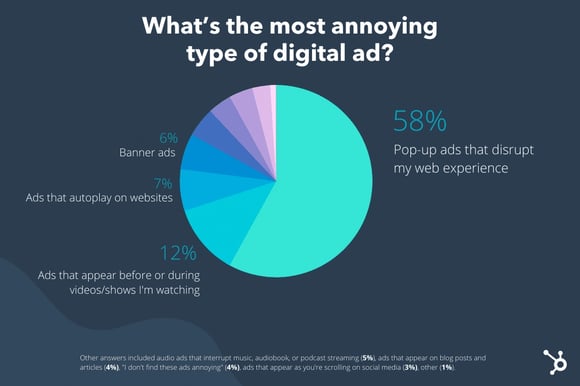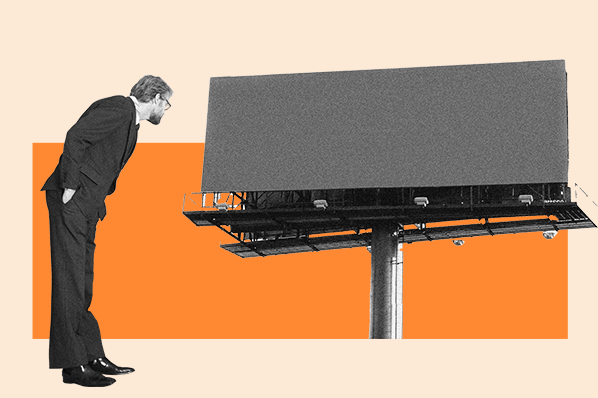A 2019 Edelman study found that three out of four consumers avoid ads. In fact, 47% said they have changed their media habits to see fewer ads while others use ad blockers to prevent them altogether.

The reasons why vary.
Personally, I hate repetitive ads. For about a month straight, every time I would watch a YouTube video, I would see the same ad and it got more irritating every time. Mostly because I wasn't interested in the brand or its services. But the incessant nature of the ad led to me develop a negative association with the company.
So, how can brands deliver ads that audiences want to see? To know that, let's first look at what they definitely don't like.
The Most Annoying Advertisement Types
We surveyed 302 people using Lucid to ask them about what ads they're most annoyed by.
When we asked the random survey pool, "What's the most annoying type of digital ad?", a whopping 58% of respondents said pop-up ads that negatively impact the user experience.

While advertising can be unavoidable for brands based on their goals, there are ways to produce ads that don't annoy your audience. Below, we dive into the two most annoying ads types and explain how marketers and advertisers can navigate.
Pop-Up Ads.
When you think about it, this result isn't too shocking. We've all gone through it. You land on a website and before you can even scroll, you're hit with a big pop-up ad that takes up the whole screen. You close it, then get hit with another pop-up on the bottom of your screen, making it harder to navigate the site.
At this stage, many viewers just drop off.
This is an issue that affects both publishers and advertisers. The more visitors a publisher has, the higher the rate they will charge for their ad inventory. However, if a site is known to have incessant pop-up ads (looking right at you, recipe websites), visitors may be reluctant to visit that site again. This can lead to lower traffic and eventually less ad revenue.
This is equally impactful to advertisers who want users to convert on their ads. You know how they say journalists should never become the story? Well, ads should never be noticed for their placement instead of their content.
Let's say your ads are displayed in ways that hinder the user experience. At worst, consumers will start to build a negative perception of your brand and at best, they'll simply be too distracted by the placement or timing of the ad to care about the content. Either way, it's a lose-lose situation.
Pre- or Mid-Roll Video Ads
When it comes to video ads, things get tricky.
Our study found that the second most annoying ad type is the one that plays before or during a video or show. In addition, a 2019 study by RevJet found that 100% of consumers will skip the ad whenever possible.
The solution here isn't to stop producing video ads altogether. It's to leverage the short time you have to capture your audience's attention and encourage them to engage with your video.
This could be by addressing their pain points or using emotional appeal. Determining what works best for your audience will require a lot of experimentation. It may take time to figure out the right formula but once you do, you can create videos with confidence that your audience will be entertained.
Now that we know what annoys consumers, let's talk about what consumers actually want to see.
What Consumers Want in Ads
Plan your ad with user experience in mind.
When deciding on your ad format, placement, and timing, it's important to consider the user experience.
Take pop-up ads, they are inherently disruptive. In this case, you may want to display them once your user has exhibited a high-engagement behavior on the site. This can be spending X amount of minutes on a page or visiting other pages on the website.
With this tactic, your user may be less likely to dismiss your ad as they are already highly engaged with the page.
Find the right balance in ad frequency.
The RevJet study found that over 72% of consumers dislike brands with repetitive messaging in their ads.
While ad frequency can help you reach your goals, there is a point where it no longer yields positive results.
A 2020 Facebook IQ study found that for brand lift campaigns, more impressions do lead to better ad recall and action intent. However, after a certain number of impressions, the benefits plateau.
In 2019, Snapchat found that the sweet spot was one to two ads per week. However, this number can vary greatly depending on several factors.
The key takeaway is that more doesn't always equal better when it comes to users.
Don't get too invasive.
Yes, consumers like personalized ads. But there's a difference between personal and creepy, and that's the balance every brand has to strike.
We surveyed 300 people and asked them about which ads feel the most invasive. The top answer was ads based on their recent online searches.

The RevJet survey echoed these results, with 60% of consumers stating they do not find retargeting ads helpful.
What consumers may prefer are contextual and demographical ads, according to a 2020 Innovid Study. For instance, seeing an ad for a blender as you're looking up recipes or seeing an ad for a store located in your area.
There's no hard-and-fast rule for determining what's helpful or too invasive. Experiment and see what works for your brand, then use that data to inform your future ad strategy.
Keep it short and concise.
When it comes to video ads, most consumers are not willing to watch them to completion.
A key finding in the RevJet study was that users are willing to abandon their videos if it means sitting through a long ad.
Twenty-eight percent of consumers between the ages of 18 to 44 will drop off if the ad exceeds 10 seconds. That rate rises incrementally as video length increases.
That said, keep your ads short and to the point. If you do opt for a longer ad, have a strong opening that will encourage your audience to keep watching.
It's important to note that these tips provide insights into consumer perception and can help steer you in the right direction. However, it's only by experimenting that you will determine which strategies yield the best results to achieve your marketing goals.



![9 Advertising Trends to Watch in 2024 [New Data + Expert Insights]](https://blog.hubspot.com/hubfs/advertising%20trend.png)



![Email Analytics [Research]: 8 Email Marketing Metrics You Should Track](https://blog.hubspot.com/hubfs/Untitled%20design%20%2851%29.jpg)

![How to Make an Ad: A 15-Step Guide [+Expert Tips]](https://blog.hubspot.com/hubfs/how%20to%20make%20an%20ad.png)

![How Consumers Responded to Black Friday in 2022 [+ Holiday Marketing Tips]](https://blog.hubspot.com/hubfs/black-friday-ads_0.webp)